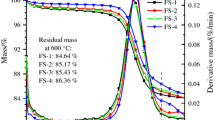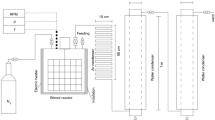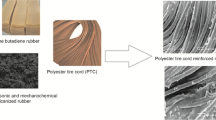Abstract
The kinetics of the radical bulk polymerization of styrene in the presence of rubber particles from recycled tires, commercially called ground tire rubber (GTR), have been studied using isothermal differential scanning calorimetry. Two different radical initiators, namely benzoyl peroxide and 2,2-azobis(2-methylbutyronitrile), were tested in a series of variable-composition experiments under three different polymerization temperatures, in order to selectively address the role of the presence of GTR on the course of the polymerization reaction. The variation of the overall effective kinetic rate constant and activation energy were also determined to quantify the effect of the presence of GTR in the reaction mixture. The results of the study demonstrate that the evolution of the monomer conversion versus time is significantly affected when the GTR content in the polymerization system is above 30 mass/%. The observed phenomena are consistent with previous results and may be primarily attributed to the chemical interactions taking place between the initiator and additives contained in the mixture.








Similar content being viewed by others
Notes
According to the Alfrey and Price Q and e scheme, the e-value is a characteristic constant value of individual vinyl monomers that accounts for the polarity of their double bonds; as such, it categorizes them into electron-rich (negative e) and electron-poor (positive e) monomers. Accordingly, the e-value of theses monomers is directly related to their reactivity [35].
References
Ramarad S, Khalid M, Ratnam C, Chuah A, Rashmi W. Waste tire rubber in polymer blends: a review on the evolution, properties and future. Prog Mater Sci. 2015;72:100–40. https://doi.org/10.1016/j.pmatsci.2015.02.004.
Dobrota D, Dobrota G. An innovative method in the regeneration of waste rubber and the sustainable development. J Clean Prod. 2018;172:3591–9. https://doi.org/10.1016/j.jclepro.2017.03.022.
Letcher T, Vallero D. Waste: a handbook for management. 2nd ed. Durham: Elsevier; 2019.
HuiLin L, XiaoPing W, DeMin J. Recycling of waste rubber powder by mechano-chemical modification. J Clean Prod. 2020;. https://doi.org/10.1016/j.jclepro.2019.118716.
Formela K, Hejna A, Zedler L, Colom Fajula X, Cañavate Ávila FJ. Microwave treatment in waste rubber recycling-recent advances and limitations. Express Polym Lett. 2019;13(6):565–88.
Mark JE, Erman B, Eirich FR. Science and technology of rubber. 3rd ed. Durham: Elsevier; 1994.
Tuchman D, Rosen S. The mechanical properties of plastics containing cryogenically ground tire. J Elastom Plast. 1978;10(2):115–28. https://doi.org/10.1177/009524437801000203.
Karger-Kocsis J, Meszaros L, Barany T. Ground tyre rubber (GTR) in thermoplastics, thermosets, and rubbers. J Mater Sci. 2013;48(1):1–38. https://doi.org/10.1007/s10853-012-6564-2.
Pittolo M, Burford R. Rubber-crumb modified polystyrene. J Mater Sci. 1986;21(5):1769–74. https://doi.org/10.1007/BF01114738.
Brydon A, Burnett GM, Cameron GG. Free-radical grafting of monomers to polydienes I. Effect of reaction conditions on grafting of styrene to polybutadiene. J Polym Sci Polym Chem Ed. 1973;11(12):3255–69. https://doi.org/10.1002/pol.1973.170111218.
Coiai S, Passaglia E, Ciardelli F, Tirelli D, Peruzzotti F, Resmini E. Modification of cross-linked rubber particles by free radical polymerization. Macromol Symp. 2006;234(1):193–202. https://doi.org/10.1002/masy.200650225.
Achilias D, Nikolaidis A, Karayannidis G. PMMA/organomodified montmorillonite nanocomposites prepared by in situ bulk polymerization. J Therm Anal Calorim. 2010;102(2):451–60. https://doi.org/10.1007/s10973-010-0935-1.
Achilias D. Investigation of the radical polymerization kinetics using DSC and mechanistic or isoconversional methods. J Therm Anal Calorim. 2014;116(3):1379–86. https://doi.org/10.1007/s10973-013-3633-y.
Rodriguez E. The effect of free radical initiators and fillers on the cure of unsaturated polyester resins. Polym Eng Sci. 1991;31(14):1022–8. https://doi.org/10.1002/pen.760311405.
Xiong R (2010) Studies in polymer composites based on carbon containing pulverized rubber materials. Ph.D. thesis, Illinois Institute of Technology, Chicago
Bera O, Radicevic R, Stoiljkovic D, Jovicic M, Pavlicevic J. A new approach for the kinetic modeling of free radical bulk polymerization of styrene. Polym J. 2011;43(10):826–31. https://doi.org/10.1038/pj.2011.76.
Marten F, Hamielec A. High-conversion diffusion-controlled polymerization of styrene. I. J Appl Polym Sci. 1982;27(2):489–505. https://doi.org/10.1002/app.1982.070270213.
Odian G. Principles of polymerization. 4th ed. Hoboken: Wiley-Interscience; 2004.
Tong L, Kenyon W. Heats of polymerization. III. Styrene and substituted styrenes. J Am Chem Soc. 1947;69(6):1402–5. https://doi.org/10.1021/ja01198a048.
Kraus G, Gruver J, Rollmann K. Inhibition of polymerization by carbon blacks. J Polym Sci. 1959;36(130):564–5. https://doi.org/10.1002/pol.1959.1203613066.
Ohkita K, Tsubokawa N, Saitoh E, Noda M, Takashina N. The free radical polymerization of vinyl monomers in the presence of carbon black. Carbon. 1975;13(5):443–8. https://doi.org/10.1016/0008-6223(75)90017-2.
Kiatkamjornwong S, Pomsanam P. Synthesis and characterization of styrenic-based polymerized toner and its composite for electrophotographic printing. J Appl Polym Sci. 2003;89(1):238–48. https://doi.org/10.1002/app.12085.
Yan J, Wang C, Gao Y, Zheng Z, Cheng Z, Cui X, Wang H. Experimental investigation on the role of pva in eliminating inhibition phenomenon of carbon black during the synthesis of polystyrene/carbon black composite particles. Polym Eng Sci. 2012;52(6):1309–16. https://doi.org/10.1002/pen.23072.
Yang Q, Wang L, Xiang W, Zhou J, Li J. Grafting polymers onto carbon black surface by trapping polymer radicals. Polymer. 2007;48(10):2866–73. https://doi.org/10.1016/j.polymer.2007.01.074.
ASTM-E2253-16 (2006) Standard test method for temperature and enthalpy measurement validation of differential scanning calorimeters. ASTM International www.astm.org. Accessed 13 Sept 2018
Fujiki K, Tsubokawa N, Sone Y. Radical grafting from carbon black. Graft polymerization of vinyl monomers initiated by Azo groups introduced onto carbon black surface. Polym J. 1990;22(8):661–70. https://doi.org/10.1295/polymj.22.661.
Hoppe S Contribution à l’étude de deux procédés d’élaboration de matériaux composites présentant des propriétés d’absorption aux ondes hyperfréquences. Ph.D. thesis, Institut National Polytechnique de Lorraine (INPL). Ecole Nationale Supérieure des Industries Chimiques, France 1995
Ueda J, Yamaguchi H, Shirai K, Yamauchi T, Tsubokawa N. Radical polymerization of vinyl monomers in the presence of carbon black initiated by 2,2’-azobisisobutyronitrile and benzoyl peroxide in ionic liquid. J Appl Polym Sci. 2008;107(5):33006–305. https://doi.org/10.1002/app.27448.
Yan J, Miao X, Zhang Q, Cui X, Li J, Wang H. One-step preparation of black polystyrene particles via in situ suspension polymerization. Polym Eng Sci. 2011;51(2):294–301. https://doi.org/10.1002/pen.21829.
Zheng Z, Li W, Sun H, Cheng Z, Yan J, Wang H, Cui X. Preparation and characterization of polystyrene/modified carbon black composite beads via in situ suspension polymerization. Polym Compos. 2013;34(7):1110–8. https://doi.org/10.1002/pc.22519.
Radovic LR. Chemistry and physics of carbon. Energy Fuels. 2001;15(2):502. https://doi.org/10.1021/ef010011t.
Akzonobel Initiators and reactor additives for thermoplastics Posted. 2013. http://www.akzonobel.com/. Accessed 28 June 2018
Tsubokawa N, Fujiki K, Sone Y. Radical grafting from carbon black. Graft polymerization of vinyl monomers initiated by peroxyester groups introduced onto carbon black surface. Polym J. 1988;20(3):213–20. https://doi.org/10.1295/polymj.20.213.
Ohkita K, Tsubokawa N, Saitoh E. The competitive reactions of initiator fragments and growing polymer chains against the surface of carbon black. Carbon. 1978;16(1):41–5. https://doi.org/10.1016/0008-6223(78)90114-8.
Alfrey T, Price CC. Relative reactivities in vinyl copolymerization. J Polym Sci. 1947;2(1):101–6. https://doi.org/10.1002/pol.1947.120020112.
Balke S, Hamielec A. Bulk polymerization of methyl methacrylate. J Appl Polym Sci. 1973;17(3):905–49. https://doi.org/10.1002/app.1973.070170320.
Ohkita K, Tsubokawa N, Saitoh E, Noda M, Eguchi H. Influence of oxygen-containing groups of carbon black on the thermal polymerization of styrene. Nippon Gomu Kyokaishi. 1976;49(12):900–7. https://doi.org/10.2324/gomu.49.12_900.
Ciullo P, Hewitt N. Compounding materials. Norwich: Elsevier; 1999. https://doi.org/10.1016/B978-081551434-3.50003-8.
Sbirrazzuoli N, Vyazovkin S. Learning about epoxy cure mechanisms from isoconversional analysis of DSC data. Thermochim Acta. 2002;388(1–2):289–98. https://doi.org/10.1016/S0040-6031(02)00053-9.
Kondratiev V. Comprehensive chemical kinetics. Chain reactions, vol. 2. Durham: Elsevier; 1969. https://doi.org/10.1016/B978-0-444-40674-3.50008-0.
Flory P. Principles of polymer chemistry. 19th ed. Ithaca: Cornell University Press; 2006.
Funding
Funding was provided by État-Région Grand Est (Grant No. CPER 2015-2020).
Author information
Authors and Affiliations
Corresponding author
Additional information
Publisher's Note
Springer Nature remains neutral with regard to jurisdictional claims in published maps and institutional affiliations.
Appendix
Appendix
A simplified kinetic scheme of radical polymerization typically consists of a sequence of three steps, involving radical initiation (Eq. 6), propagation (Eq. 7) and termination (Eq. 9) reactions. To this classical kinetic scheme, one can include a generalized inhibition reaction (Eq. 8), when supporting indications or evidence exist. In the present work, Z designates, in a generalized manner, all those elements of GTR that may act as inhibitor or retarder in the course of the polymerization. Hence, the following kinetic scheme can be formulated:
where I, \(MZ\cdot\) and P denote the initiator, inhibited radical and terminated polymer radical, respectively. f is the initiator efficiency while \(k_{\mathrm{d}}\), \(k_{\mathrm{p}}\), \(k_{\mathrm{z}}\) and \(k_{\mathrm{t}}\) are the respective kinetic rate constants of the initiator decomposition, radical propagation, deactivation (i.e., by inhibitor) and termination (e.g., by combination or disproportionation) reactions. On the basis of the postulated kinetic scheme (Eqs. 6–9), and under the assumptions of constant radical concentration and the LCH, Eq. (10) can be derived via direct integration of Eq. (2), to express the variation of the monomer concentration (or equivalently monomer conversion) with respect to reaction time:
To express the concentration of radicals, \(M\cdot\), the QSSA can be applied to yield the following equation:
Note that the reactivity of the radical \(MZ\cdot\) is assumed here to be too low to further promote polymerization. Also, the decomposition rate constant, \(k_{\mathrm{d}}\), corresponds to the overall decomposition rate of the initiator, including thermal homolysis and eventual redox decomposition. From the above expression it can be seen that, when all terms are important, the final expression of \(M\cdot\) will be a root of the second-order algebraic equation whose generalized form cannot be simplified. In contrast, significant simplification can be achieved if one considers two extreme cases for the radical termination mechanism; the first one corresponds to the case where radical termination can be considered to occur primarily by bi-radical termination (Eq. 9), considering inhibition reactions (Eq. 8) as negligible. In this case, the expression of \(M\cdot\) is reduced to the commonly employed :
The second case corresponds to the conditions where the radical inhibition reactions (Eq. 8) are considered as the dominant mechanism of radical termination, thus resulting in the following expression for \([M\cdot ]\):
Rights and permissions
About this article
Cite this article
Florez, D., Hoppe, S., Hu, GH. et al. Radical bulk polymerization of styrene in the presence of rubber particles from recycled tires: a kinetic study using DSC. J Therm Anal Calorim 143, 3073–3084 (2021). https://doi.org/10.1007/s10973-020-09701-z
Received:
Accepted:
Published:
Issue Date:
DOI: https://doi.org/10.1007/s10973-020-09701-z




